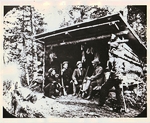A Brief History of Musical Influences in the Adirondack Woods
While
it’s likely that earlier Paleolithic aboriginal peoples that passed through the
area would have had vocal and/or percussive instrumental music of some kind,
the earliest indigenous music-making we can be fairly certain of in the
Adirondack Mountains came from the Mohawk Indians of the Iroquois Nation. Based in the level, more fertile lands of the
Mohawk Valley south of the Adirondacks from approximately AD 1000-1783, the
Mohawks were known to frequently hunt and trap throughout the Adirondack
region, often on quite lengthy trips.
Mohawk social songs would have been sung and played on rattles and drums, both as entertainment and for dancing, while ceremonial songs would have been reserved for the more ritualized festivals, celebrations and ceremonies that took place throughout the year in the “lowlands.” These social song traditions were not developed in the mountains, but rather were brought in and out of the mountains with the Mohawks, and they do not seem to have influenced or affected non-Native song forms in any noticeable way.
Similarly, when the early American colonists of Dutch, Palatine German, Quaker, English and Scotch-Irish ancestry came through occasionally as trappers, traders, hunters and explorers in the 1600s and 1700s along with French and British interests, they almost certainly brought their songs and instrumental tunes or “airs” with them. However, we have little or no record of this, and it seems not to have made any kind of lasting mark on the song traditions of the area.
The first permanent settlers to the area, a mix of New England Yankees, New York State residents and recent immigrants from England, Ireland and Scotland in the late 1700s, brought large stores of songs, ballads and instrumental dance tunes
that would become the bedrock of traditional music-making in the area. (See
individual sections on Singers & Songs and Fiddlers & Dance
Tunes for more on both of these topics).
Canadians
from Ontario, Quebec and the Maritime Provinces found their way into the
Adirondack woods in great numbers in the nineteenth century, and of course
brought their music with them. Some of
these musical laborers and their families spoke and sang in English; many others were French-Canadian. While some would stay permanently and others
would come and go for seasonal work, all were a constant source of inspiration
and interchange for the musicians on the American side of the border.
As traveling peddlers, itinerant laborers, wandering minstrels and others came through the area in the nineteenth century, parts of their music would be absorbed and assimilated into the local repertoire. At big public events, peddlers and hawkers also sold cheap, single sheet printings (broadsides) of song lyrics, as well as pocket songsters that contained lyrics for multiple songs. Many rural newspapers carried a regular "Old Songs" column. All of these resources reinforced, developed, and revived singers' repertoires.
Fiddle
tune sheet music and collections of tunes served the same functions for
fiddlers, "play-by-note" musicians passing along material to
"play-by-ear" musicians.
Religious hymns and church music were another source of material, as
were songs, ditties and tunes learned from traveling minstrel and general
entertainment shows (for more on minstrel shows in the
Adirondacks, see the Irish Music Traditions section).
Starting around the turn of the twentieth century and continuing to this day, commercial recordings and transmitted radio programs provided the next major change in the music-making traditions of the Adirondacks. Local singers and instrumentalists would flock to this world of new influences; most were not devoted in any rigid way to the older music. Country and western music, hillbilly recordings, ethnic music and popular and sentimental hits of the day all provided fresh new sounds to draw from. Television and later the internet would each further shape, and continue to shape, the evolving tradition.


